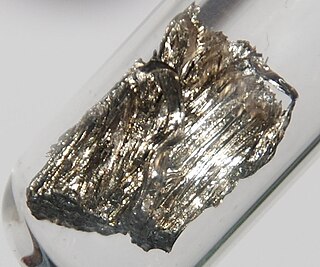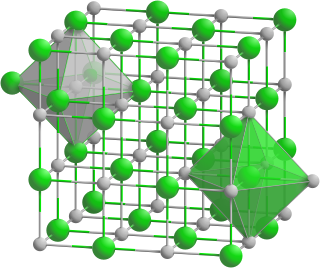
Samarium is a chemical element; it has symbol Sm and atomic number 62. It is a moderately hard silvery metal that slowly oxidizes in air. Being a typical member of the lanthanide series, samarium usually has the oxidation state +3. Compounds of samarium(II) are also known, most notably the monoxide SmO, monochalcogenides SmS, SmSe and SmTe, as well as samarium(II) iodide.
Titanium(III) phosphide (TiP) is an inorganic chemical compound of titanium and phosphorus. Normally encountered as a grey powder, it is a metallic conductor with a high melting point. It is not attacked by common acids or water. Its physical properties stand in contrast to the group 1 and group 2 phosphides that contain the P3− anion (such as Na3P), which are not metallic and are readily hydrolysed. Titanium phosphide is classified as a "metal-rich phosphide", where extra valence electrons from the metal are delocalised.
Strontium phosphide is an inorganic compound of strontium and phosphorus with the chemical formula Sr
3P
2. The compound looks like black crystalline material.
Samarium(III) bromide is a crystalline compound of one samarium and three bromine atoms with the chemical formula of SmBr3. Samarium(III) bromide is a dark brown powder at room temperature. The compound has a crystal structure isotypic to that of plutonium(III) bromide.

Yttrium phosphide is an inorganic compound of yttrium and phosphorus with the chemical formula YP. The compound may be also classified as yttrium(III) phosphide.
Lithium phosphide is an inorganic compound of lithium and phosphorus with the chemical formula Li
3P.

Scandium phosphide is an inorganic compound of scandium and phosphorus with the chemical formula ScP.
Lutetium phosphide is an inorganic compound of lutetium and phosphorus with the chemical formula LuP. The compound forms dark crystals, does not dissolve in water.
Praseodymium monophosphide is an inorganic compound of praseodymium and phosphorus with the chemical formula PrP. The compound forms crystals.
Neodymium phosphide is an inorganic compound of neodymium and phosphorus with the chemical formula NdP.
Europium phosphide is an inorganic compound of europium and phosphorus with the chemical formula EuP. Other phosphides are also known.

Lanthanum phosphide is an inorganic compound of lanthanum and phosphorus with the chemical formula LaP.
Ytterbium(III) phosphide is an inorganic compound of ytterbium and phosphorus with the chemical formula YbP. This is one of the phosphides of ytterbium.
Thulium phosphide is an inorganic compound of thulium and phosphorus with the chemical formula TmP.
Holmium phosphide is a binary inorganic compound of holmium and phosphorus with the chemical formula HoP. The compound forms dark crystals and does not dissolve in water.
Dysprosium phosphide is an inorganic compound of dysprosium and phosphorus with the chemical formula DyP.
Samarium(III) arsenide is a binary inorganic compound of samarium and arsenic with the chemical formula SmAs.
Samarium compounds are compounds formed by the lanthanide metal samarium (Sm). In these compounds, samarium generally exhibits the +3 oxidation state, such as SmCl3, Sm(NO3)3 and Sm(C2O4)3. Compounds with samarium in the +2 oxidation state are also known, for example SmI2.
Erbium compounds are compounds containing the element erbium (Er). These compounds are usually dominated by erbium in the +3 oxidation state, although the +2, +1 and 0 oxidation states have also been reported.
Ytterbium compounds are chemical compounds that contain the element ytterbium (Yb). The chemical behavior of ytterbium is similar to that of the rest of the lanthanides. Most ytterbium compounds are found in the +3 oxidation state, and its salts in this oxidation state are nearly colorless. Like europium, samarium, and thulium, the trihalides of ytterbium can be reduced to the dihalides by hydrogen, zinc dust, or by the addition of metallic ytterbium. The +2 oxidation state occurs only in solid compounds and reacts in some ways similarly to the alkaline earth metal compounds; for example, ytterbium(II) oxide (YbO) shows the same structure as calcium oxide (CaO).

